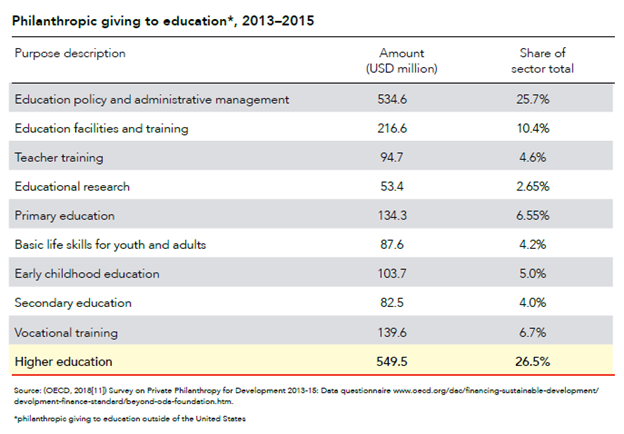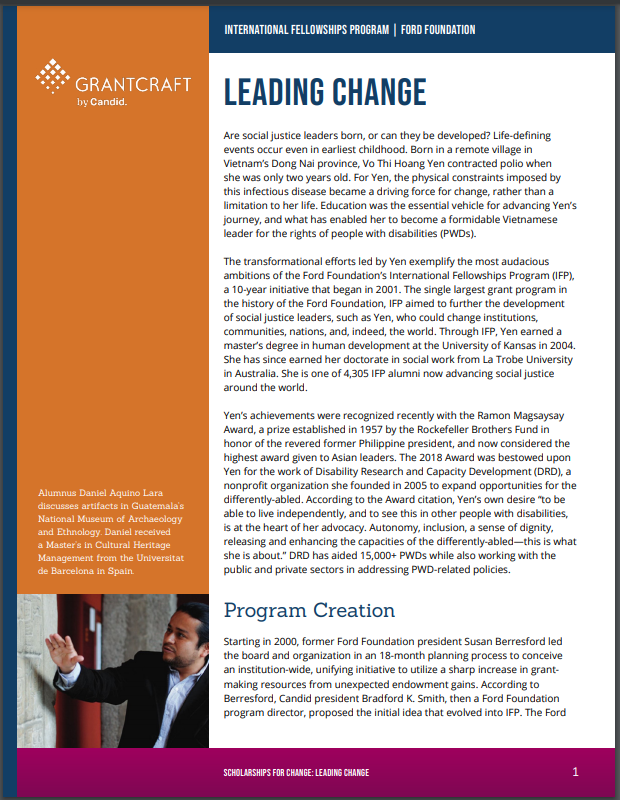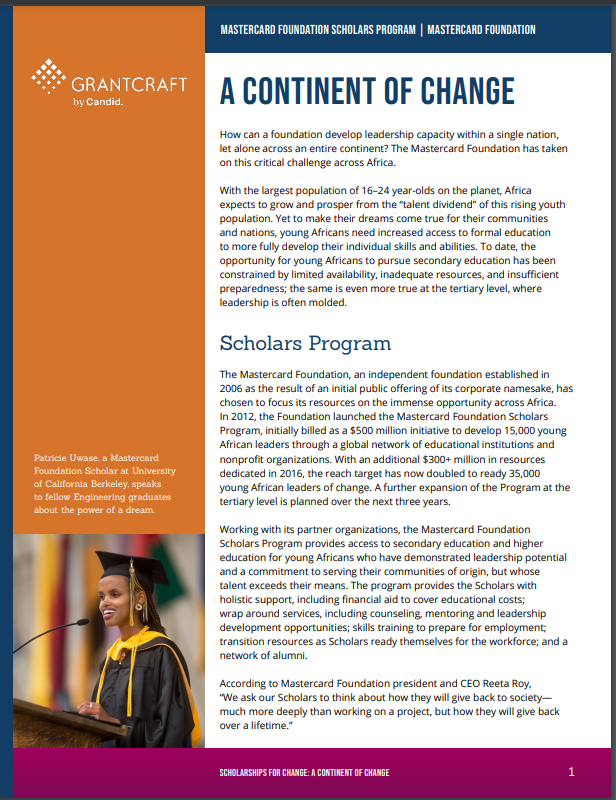Higher Education Access and Equity: Why a Social Justice Approach Matters
Higher education and social change are inextricably linked: by providing access to education, a scholarship program provides access to knowledge, resources, and opportunity for not only an individual, but also a community. With many developing countries experiencing youth bulges and a growing young adult population, making higher education more accessible to underserved communities all around the world is a pressing issue. But who is responsible for driving and funding these efforts? As we can see from Candid’s Scholarships for Change case studies and platform, more and more foundations are playing a role in establishing and shaping scholarships as a means to create broader social change.
>>Learn more about how philanthropy is using scholarships to impact society in a broader way, aiming to change whole institutions, industries, and specific communities through these awards at Scholarships for Change.
Foundation philanthropic participation in higher education is not new, but why are they so interested, and what is driving the increase?
In the last twenty years, institutional philanthropy has played an increasing role in international development and aid. Problems of access and equity – and the gaps created between privileged and underprivileged communities – have made a solid case for necessary funding expansion. Foundations have traditionally been seen as fit players, certainly capable of contributing to this growing demand.
In a recent study by the Institute of International Education, we explored the link between philanthropy, higher education, and social justice by asking why foundations are investing more in international higher education and which endeavors have been successful in bringing about positive social change.

So, if access and equity are driving forces behind foundations’ involvement in higher education, are these efforts effective?
The short answer? Sometimes.
Two preliminary findings emerged in our study. First, while foundation investment in higher education has increased overall, largescale efforts to break down barriers to pervasive education access are not widespread. While themes of higher education access and equity have risen to the top of the development agenda, outcomes differ considerably from one context to another. There is an evident need for more foundations to support these initiatives.
Second, there is no one-size-fits-all approach. Exclusion factors span from the quality of secondary education, geographical isolation, differentiation within ethnic and racial groups, lack of access to information, or simply being born or living in a region characterized by chronic marginalization. Programs that tackle higher education should take a nuanced approach to understand the context of the populations they are supporting, not focus solely on blanket approaches to scale-up.
So how can foundations be sure they are investing effectively?
Let’s be honest: In today’s context, the provision of higher education in and of itself is not an effective or sustainable approach.
It needs to be the responsibility of every foundation working in higher education to ensure that their program includes a well-informed strategy to target underprivileged individuals. Programs that focus solely on academic excellence, for example, are more likely to select students from privileged backgrounds that will contribute to a growing gap in individuals from upper and lower economic strata. Without addressing the roots of inequality and systematically supporting those who are traditionally excluded, education and exclusion gaps will remain.
The second part of our recent study asked what we could learn from recent higher education programs that have been successful in bringing about positive social change through scholarships and fellowships. How can foundations working in the sphere of higher education ensure that their money is well spent? A few promising practices have been observed in different parts of the world and they deserve to be highlighted and duplicated.
How can we make this happen?
Make a Common Agenda with the Right Partners
Our study noted that higher education scholarship and fellowship programs that have common agendas, whether between donors and academic institutions or between government and international partners, often lead to sustainable partnerships and better program outcomes grounded in shared goals and visions. For example, one way to do this is to decentralize coordination and work with local grassroots organizations to understand marginalized communities, help identify individuals who need support, and provide the necessary context and nuance for long-term engagement. These organizations are often the most connected to the communities they work with; they have access and know how best to engage with them.
Provide Holistic Support
Let us also recognize that supporting students from underserved communities is complex and identifying and supporting these individuals takes considerable time and resources. Our study found that programs supporting underserved communities were successful when they adopted an integrated program approach.
For example, the Ford Foundation International Fellowships Program (IFP), focused on the principle that higher education is an essential long-term investment for addressing major social issues. IFP’s alumni impact study has found that the integrated nature of the program – providing pre-academic training, funding and academic supports, and additional support through networks and services – created a holistic funding model that supported Fellows before, during, and after the program. This support has manifested itself in the success the Fellows have had beyond the Fellowship. Findings from the Ford Foundation’s IFP, Mastercard Foundation Scholars Program, Dell Young Leaders program, and the Moshal Scholarship Program provide evidence that a tailored approach — often centered on individual’s needs — extends well beyond financing the degree. It’s essential to provide financial, social, emotional, and job market support to further help people from disadvantaged communities overcome their challenges to completing their higher education.


Document Impacts for Decision-making
Finally, it is imperative to measure and document the impact of higher education scholarships and fellowships. Think ahead and plan for meaningful monitoring, evaluation, and learning strategies that will give you valuable data about your higher education scholarship initiatives. This will allow you to demonstrate the return on investments – particularly the social impacts of investing in individuals for social justice – to your stakeholders and promote an evidence-based decision-making culture.
In conclusion, higher education remains a key pathway for social mobility and economic opportunity. Equally important, providing educational opportunities for the most underserved populations continues to be a worldwide priority providing a key pathway for donors to make an impact. If individuals are not presented with the same opportunities, the equity and access gaps will widen, and social mobility and economic opportunity will be compromised.
Adopting a social justice approach to higher education is a win-win situation and, candidly, the one the world needs right now more than ever.



